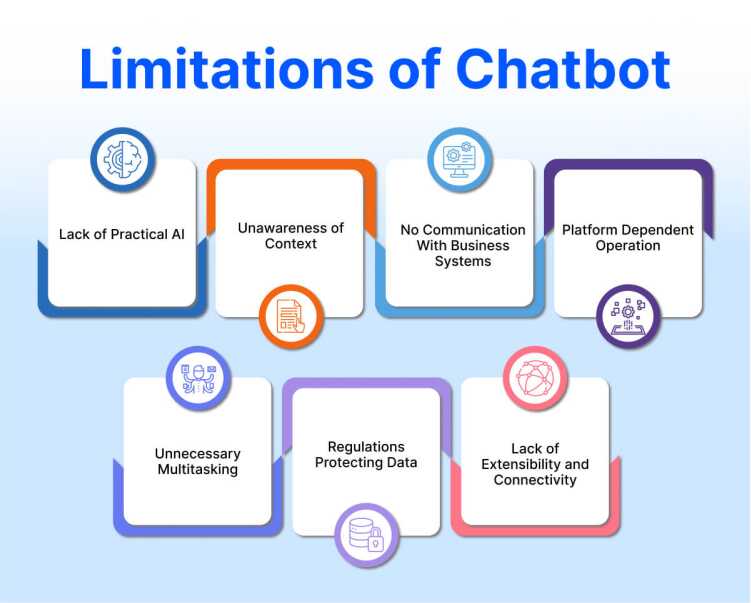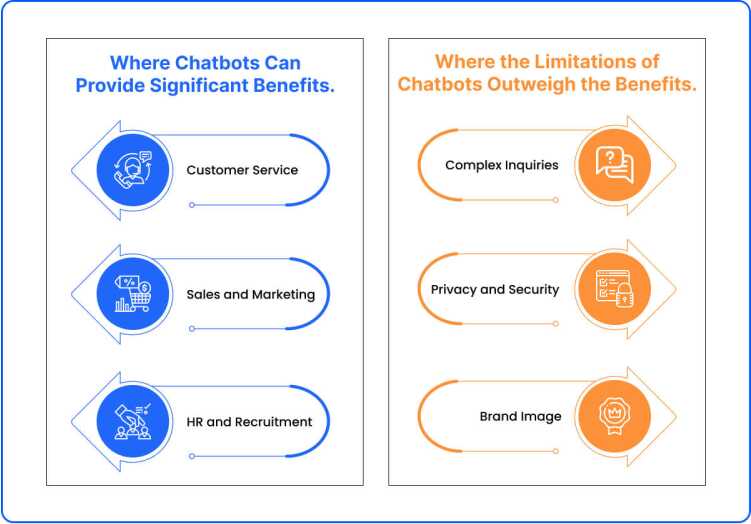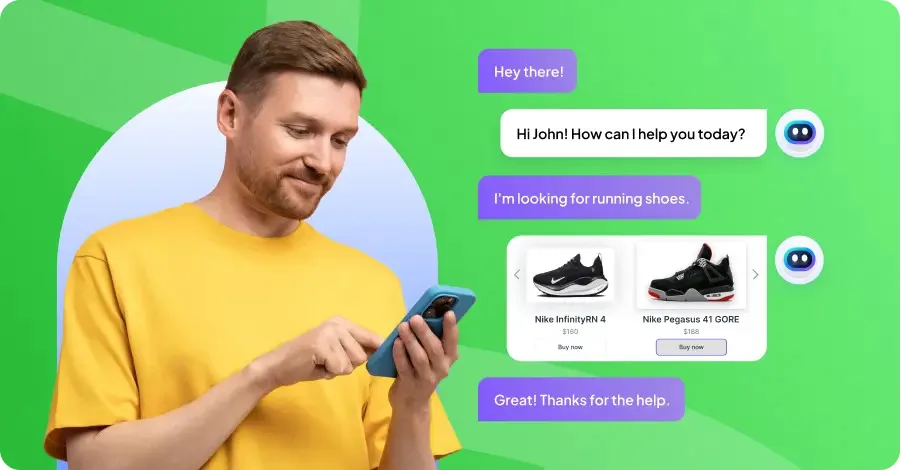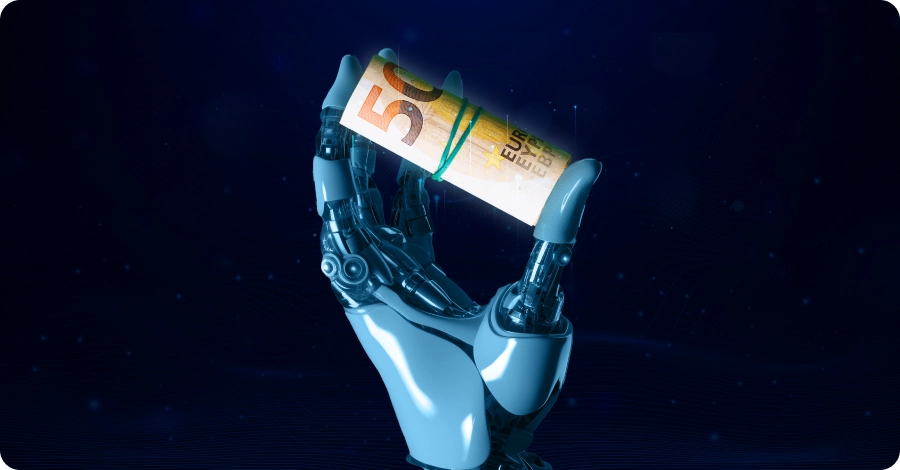The Limitations of Chatbots: What You Need to Know?
- April 17, 2023
- 8 mins read
- Listen

Table of Content
Chatbots have become an increasingly popular way for businesses to engage with customers and automate certain tasks. From customer support to sales and marketing, chatbots offer a range of benefits.
However, as with any technology, there are limitations to what chatbots can do. In this blog post, we’ll explore some of the common limitations of chatbots and why it’s important to be aware of them before implementing one for your business.
7 Limitations of Chatbot

There is no doubt that AI chatbots have some limitations. While they can be incredibly useful in automating tasks and providing 24/7 customer support, there are certain limitations to what they can do. Let’s find the limitations of chatbots.
1. Lack of Practical AI
AI chatbots are built to mimic human interactions, but they lack the practical intelligence to understand complex situations or provide personalized attention. They can handle simple and repetitive tasks, but when it comes to addressing complex issues, chatbots often fall short.
Some of the reasons for this limitation include a lack of contextual understanding, inability to reason, and difficulty in adapting to new situations. While AI chatbots have the potential to learn and improve, their capabilities are still limited by the available technology and data.
- AI chatbots lack the ability to understand complex human emotions and nuanced responses.
- They can only provide answers based on the data they have been trained on and cannot learn new information on their own.
- They may struggle with more complex issues that require human intervention.
- The lack of practical AI can lead to frustration and dissatisfaction among users.
2. Unawareness of Context
Another limitation of chatbots is their inability to understand the context of a conversation. They can only respond based on the keywords and phrases they have been programmed to recognize, which can lead to confusion and misinterpretation.
For example, a chatbot designed to answer customer support queries may not be able to distinguish between a general inquiry and a specific technical issue. This can lead to generic or irrelevant responses that do not address the user’s problem.
- Chatbots can struggle to understand the context of a conversation beyond basic keywords and phrases.
- This can lead to generic or irrelevant responses that do not address the user’s actual problem.
- Chatbots may not be able to distinguish between a general inquiry and a specific technical issue.
- The inability to understand context can result in frustration and dissatisfaction among users.
3. No Communication With Business Systems
Chatbots are often designed to work as standalone applications, which means they may be unable to communicate with other business systems or databases. This can limit their ability to provide accurate and up-to-date information to users.
For example, if a chatbot is designed to provide shipping information to customers, it may not be able to access real-time data from the shipping provider’s system. This can lead to delays and inaccurate information being provided to the user.
- Chatbots may not be able to communicate with other business systems or databases.
- This can limit their ability to provide accurate and up-to-date information to users.
- The lack of integration with business systems can result in delays and inaccurate information being provided to the user.
- Chatbots may need to be manually updated with new information, which can be time-consuming and inefficient.
4. Platform-Dependent Operation
Another limitation of chatbots is their platform-dependent operation. Chatbots are often designed to work on specific platforms, such as Facebook Messenger or Slack, which can limit their reach and effectiveness.
For example, if a business only uses Facebook Messenger for customer support, users who prefer to use other messaging apps will not be able to access the chatbot. This can limit the chatbot’s ability to reach a wider audience and provide support to all users.
- Chatbots may be designed to work on specific platforms, which can limit their reach and effectiveness.
- Users who prefer to use other messaging apps will not be able to access the chatbot.
- The platform-dependent operation can limit the chatbot’s ability to reach a wider audience and provide support to all users.
- Developing chatbots for multiple platforms can be time-consuming additions to Protecting Data.
5. Unnecessary Multitasking
Chatbots are often used to handle multiple tasks at once, but this can lead to unnecessary multitasking that reduces their effectiveness. It may struggle to handle multiple tasks simultaneously, leading to delays, errors, and a lower quality of service.
For example, a chatbot designed to handle customer support inquiries may also be tasked with providing sales information, which can lead to confusion and slower response times.
- Chatbots may be tasked with handling multiple tasks simultaneously, leading to unnecessary multitasking.
- It can lead to delays, errors, and a lower quality of service.
- It may struggle to handle multiple tasks simultaneously, leading to confusion and slower response times
- It’s important to consider the workload and capabilities of the chatbot before assigning it multiple tasks.
6. Regulations Protecting Data
Chatbots often collect personal and sensitive data from users, which makes it important to comply with regulations protecting user privacy and data. This can be challenging for businesses that may not have the expertise or resources to comply with these regulations.
For example, the General Data Protection Regulation (GDPR) in the EU requires businesses to obtain explicit consent from users before collecting their data. Failure to comply with these regulations can lead to fines and legal action.
- Chatbots often collect personal and sensitive data from users, which makes it important to comply with regulations protecting user privacy and data.
- Businesses may not have the expertise or resources to comply with these regulations.
- Failure to comply with these regulations can lead to fines and legal action.
- It’s important for businesses to understand and comply with relevant regulations before implementing chatbots.
7. Lack of Extensibility and Connectivity
Chatbots may be limited by their lack of extensibility and connectivity. It may not be able to connect with other systems or APIs, which can limit its functionality and effectiveness.
For example, a chatbot designed to handle customer support inquiries may not be able to connect with a payment gateway to process refunds. This can limit the chatbot’s ability to provide a complete solution to the user.
- The lack of connectivity can limit the chatbot’s ability to provide a complete solution to the user.
- It’s important to consider the connectivity and extensibility of the chatbot before implementing it in your business.
Do the Benefits of Chatbots Outweigh the Limitations?

Whether the benefits of chatbots outweigh the limitations depends on the specific use case and context in which they are being used.
In many cases, chatbots can provide significant benefits, such as improved customer service, increased efficiency, and reduced costs. However, in other cases, the limitations of chatbots may outweigh the benefits.
Here are some examples of where chatbots can provide significant benefits:
- Customer service: Chatbots can provide 24/7 support, respond quickly to customer inquiries, and provide personalized assistance, improving customer satisfaction and loyalty.
- Sales and marketing: It can automate lead generation and qualification, provide product recommendations, and facilitate purchases, leading to increased revenue and conversion rates.
- HR and recruitment: Chatbots can automate the screening of candidates, schedule interviews, and answer frequently asked questions, reducing the workload of HR staff and improving the candidate experience.
However, there are also cases where the limitations of chatbots may outweigh the benefits:
- Complex inquiries: Chatbots may struggle to handle complex inquiries or those that require human judgment or empathy, leading to frustration and dissatisfaction among users.
- Privacy and security: Chatbots may collect sensitive data from users, and if not implemented properly, may pose a risk to user privacy and security.
- Brand image: Chatbots may not be able to provide the level of personalization and human touch that some users expect, which can impact the brand image and reputation.
Therefore, it’s important to carefully consider the use case and context in which chatbots are being used, and weigh the potential benefits against the limitations before implementing them in your business.
Summary
Chatbots have become increasingly popular in recent years due to their ability to automate tasks, provide 24/7 support, and improve efficiency. However, they also have their limitations, including lack of practical AI, unawareness of context, platform-dependent operation, unnecessary multitasking, regulations protecting data, and lack of extensibility and connectivity.
To maximize the benefits of chatbots and overcome their limitations, it’s important to ensure they are designed and implemented properly, with a focus on user experience, privacy and security, and connectivity with other systems. By taking these factors into account, businesses can make the most of chatbots and achieve their desired outcomes.
Frequently Asked Questions
There are 7 limitations of a chatbot and they are:
- Lack of Practical AI
- Unawareness of Context
- No Communication With Business Systems
- Platform-Dependant Operation
- Unnecessary Multitasking
- Regulations Protecting Data
- Lack of Extensibility and Connectivity
People are not happy with chatbots because they can sound very robotic and lack any form of empathy. Also, chatbots are sometimes inadequate at solving problems and that can frustrate customers.
Chatbots are not inherently unethical but training with the wrong data can cause chatbots to act unethically.



